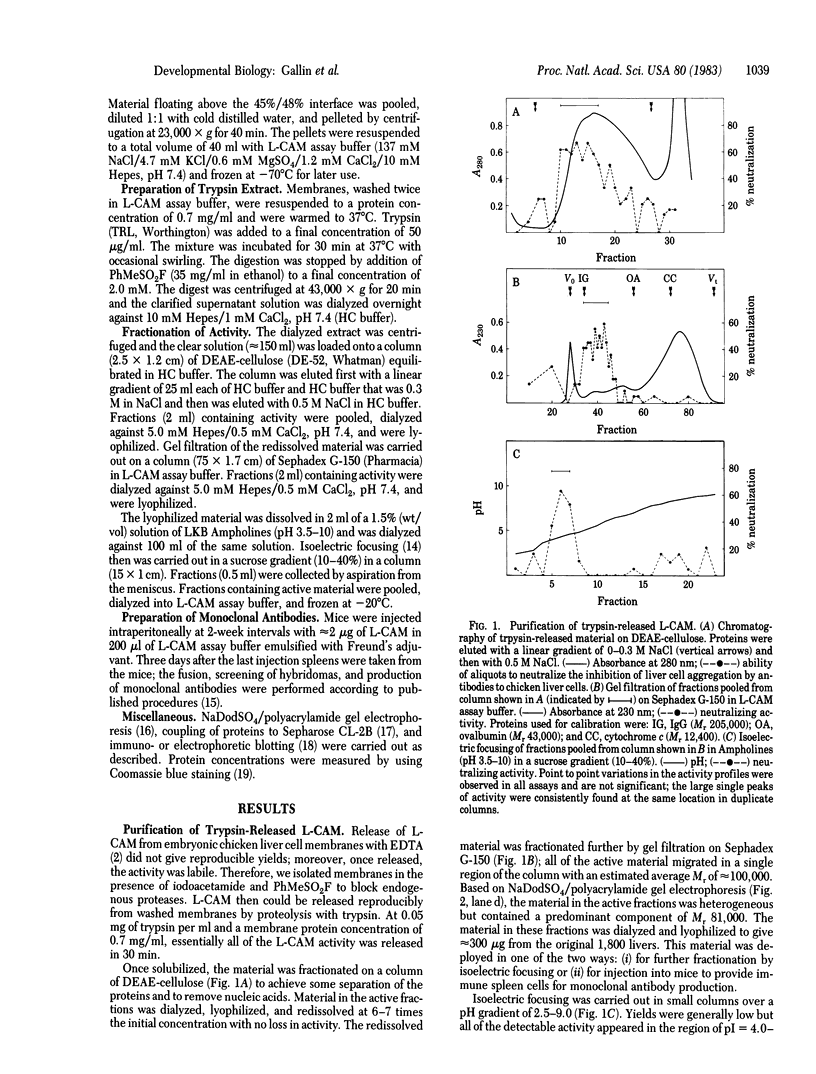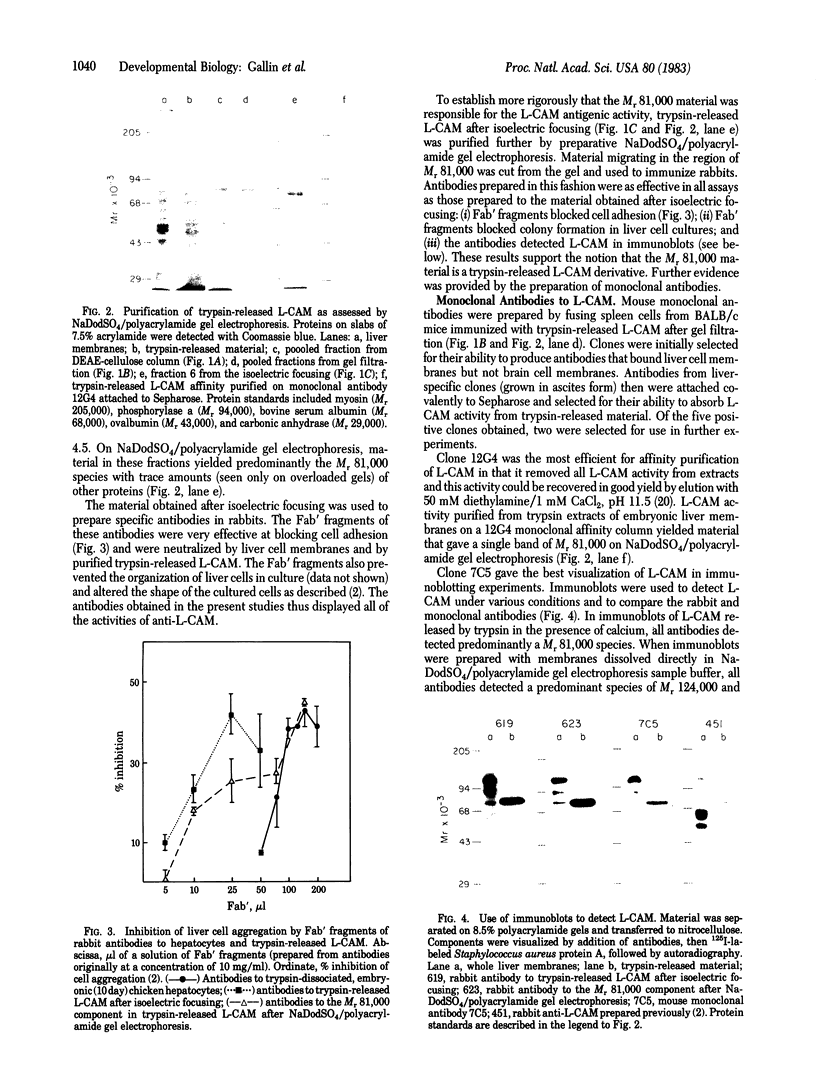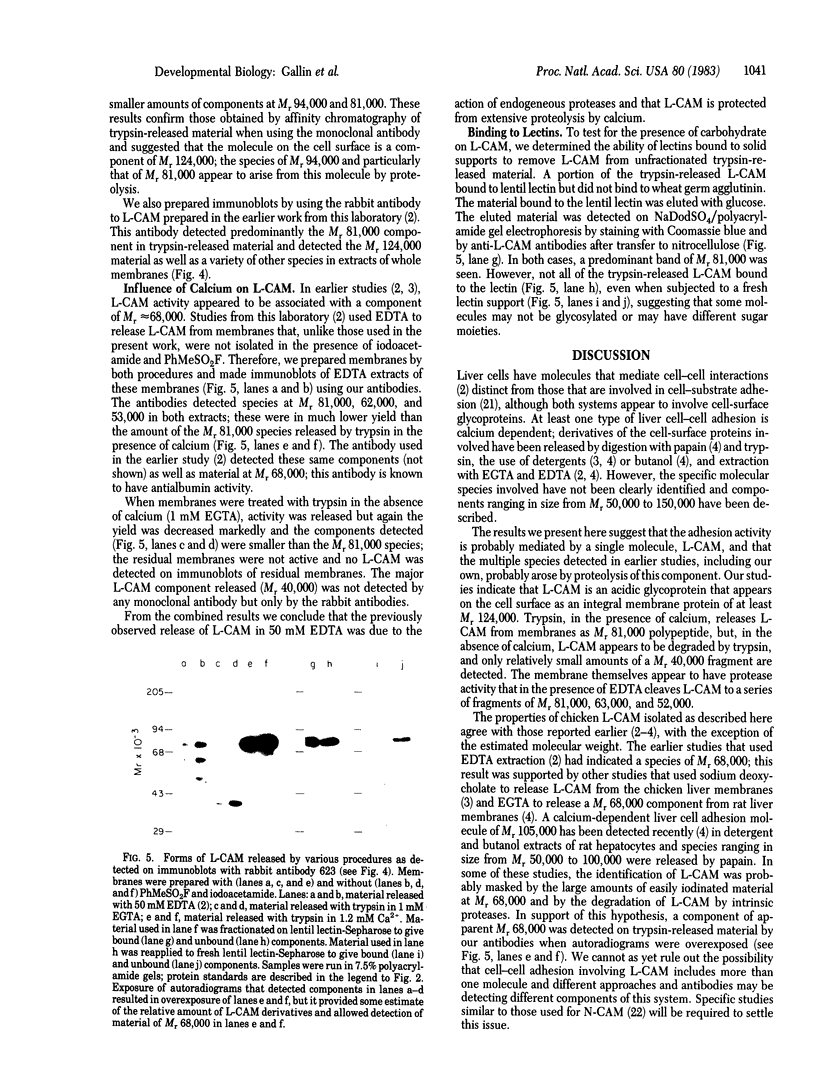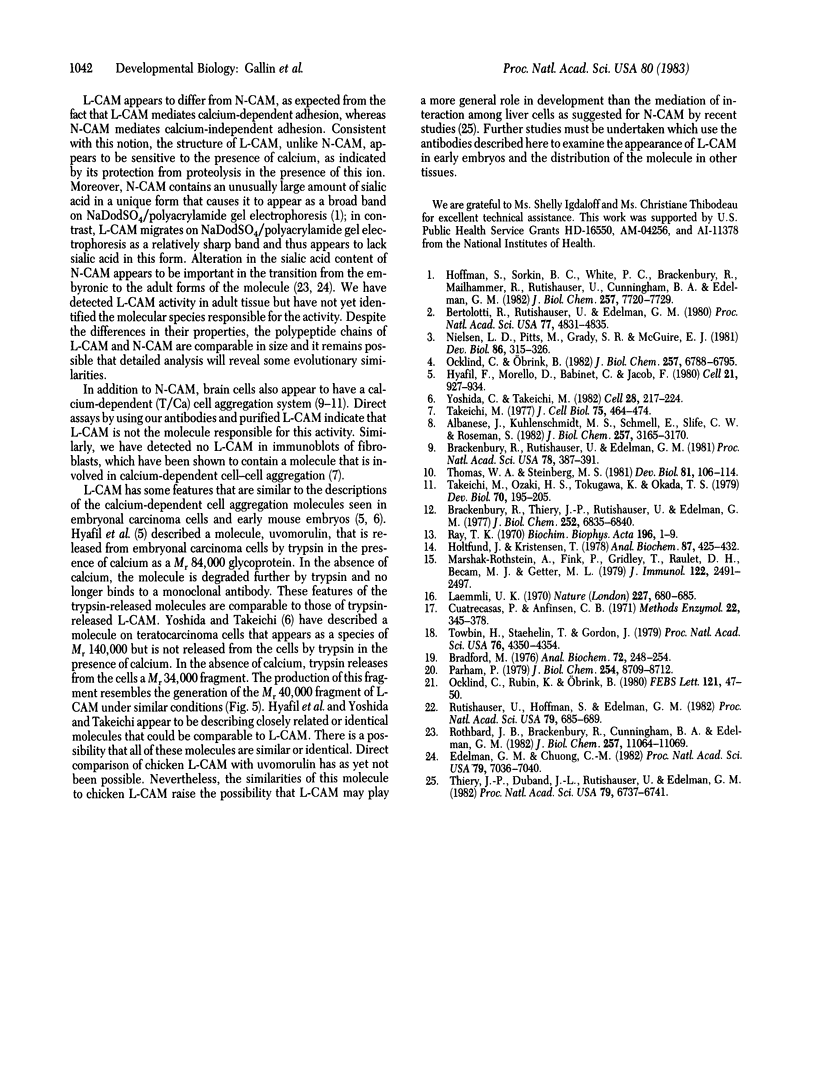Abstract
We have developed a method for purifying L-CAM, the cell adhesion molecule from embryonic chicken liver cells, and have compared its properties with those of N-CAM, the neural cell adhesion molecule. L-CAM was released from membranes with trypsin, purified by a series of chemical techniques, and used to generate monoclonal antibodies which allowed the identification of the intact L-CAM molecule from membranes. The monoclonal antibodies were used to isolate trypsin-released L-CAM in a single step by affinity chromatography. Material purified by either technique was predominantly a component of Mr 81,000 on NaDodSO4/polyacrylamide gel electrophoresis with a pI of 4.0-4.5. Rabbit antibodies to this component and to the Mr 81,000 species that had been further purified on NaDodSO4/polyacrylamide gel electrophoresis displayed all of the activities of anti-L-CAM. Some of the trypsin-released L-CAM bound specifically to lentil lectin, suggesting that L-CAM is a glycoprotein. The apparent molecular weight of material having L-CAM antigenic determinants depended upon the procedures used to extract membranes; this appears to account for the various values reported previously in the literature. Both the rabbit serum antibodies and the monoclonal antibodies detected the Mr 81,000 species on immunoblots of unfractionated trypsin-released material. Immunoblots of whole liver cell membranes with the same antibodies revealed a major Mr 124,000 component, with minor components of Mr 94,000 and 81,000. Active L-CAM derivatives released by trypsin in the presence of EGTA were detected as a species of Mr 40,000. L-CAM derivatives obtained by extraction of membranes with EDTA alone appeared as species of Mr 53,000, 62,000, and 81,000. The combined results suggest that L-CAM on the cell surface is an acidic glycoprotein of Mr 124,000. In the presence of calcium, the molecule can be released from membranes by trypsin as a soluble Mr 81,000 fragment; in the absence of calcium, it is released by either endogenous proteases or by trypsin as a variety of smaller fragments.
Keywords: cell-cell adhesion, monoclonal antibodies, hepatocytes, cleavage protection by calcium
Full text
PDF




Images in this article
Selected References
These references are in PubMed. This may not be the complete list of references from this article.
- Albanese J., Kuhlenschmidt M. S., Schmell E., Slife C. W., Roseman S. Studies on the intercellular adhesion of rat and chicken hepatocytes. Tissue-specific adhesion in mixtures of hepatocytes and heart myocytes. J Biol Chem. 1982 Mar 25;257(6):3165–3170. [PubMed] [Google Scholar]
- Bertolotti R., Rutishauser U., Edelman G. M. A cell surface molecule involved in aggregation of embryonic liver cells. Proc Natl Acad Sci U S A. 1980 Aug;77(8):4831–4835. doi: 10.1073/pnas.77.8.4831. [DOI] [PMC free article] [PubMed] [Google Scholar]
- Brackenbury R., Rutishauser U., Edelman G. M. Distinct calcium-independent and calcium-dependent adhesion systems of chicken embryo cells. Proc Natl Acad Sci U S A. 1981 Jan;78(1):387–391. doi: 10.1073/pnas.78.1.387. [DOI] [PMC free article] [PubMed] [Google Scholar]
- Brackenbury R., Thiery J. P., Rutishauser U., Edelman G. M. Adhesion among neural cells of the chick embryo. I. An immunological assay for molecules involved in cell-cell binding. J Biol Chem. 1977 Oct 10;252(19):6835–6840. [PubMed] [Google Scholar]
- Bradford M. M. A rapid and sensitive method for the quantitation of microgram quantities of protein utilizing the principle of protein-dye binding. Anal Biochem. 1976 May 7;72:248–254. doi: 10.1016/0003-2697(76)90527-3. [DOI] [PubMed] [Google Scholar]
- Edelman G. M., Chuong C. M. Embryonic to adult conversion of neural cell adhesion molecules in normal and staggerer mice. Proc Natl Acad Sci U S A. 1982 Nov;79(22):7036–7040. doi: 10.1073/pnas.79.22.7036. [DOI] [PMC free article] [PubMed] [Google Scholar]
- Hoffman S., Sorkin B. C., White P. C., Brackenbury R., Mailhammer R., Rutishauser U., Cunningham B. A., Edelman G. M. Chemical characterization of a neural cell adhesion molecule purified from embryonic brain membranes. J Biol Chem. 1982 Jul 10;257(13):7720–7729. [PubMed] [Google Scholar]
- Holtlund J., Kristensen T. A method for density gradient isoelectric focusing in small scale. Anal Biochem. 1978 Jul 1;87(2):425–432. doi: 10.1016/0003-2697(78)90692-9. [DOI] [PubMed] [Google Scholar]
- Hyafil F., Morello D., Babinet C., Jacob F. A cell surface glycoprotein involved in the compaction of embryonal carcinoma cells and cleavage stage embryos. Cell. 1980 Oct;21(3):927–934. doi: 10.1016/0092-8674(80)90456-0. [DOI] [PubMed] [Google Scholar]
- Laemmli U. K. Cleavage of structural proteins during the assembly of the head of bacteriophage T4. Nature. 1970 Aug 15;227(5259):680–685. doi: 10.1038/227680a0. [DOI] [PubMed] [Google Scholar]
- Marshak-Rothstein A., Fink P., Gridley T., Raulet D. H., Bevan M. J., Gefter M. L. Properties and applications of monoclonal antibodies directed against determinants of the Thy-1 locus. J Immunol. 1979 Jun;122(6):2491–2497. [PubMed] [Google Scholar]
- Nielsen L. D., Pitts M., Grady S. R., McGuire E. J. Cell-cell adhesion in the embryonic chick: partial purification of liver adhesion molecules from liver membranes. Dev Biol. 1981 Sep;86(2):315–326. doi: 10.1016/0012-1606(81)90189-5. [DOI] [PubMed] [Google Scholar]
- Ocklind C., Obrink B. Intercellular adhesion of rat hepatocytes. Identification of a cell surface glycoprotein involved in the initial adhesion process. J Biol Chem. 1982 Jun 25;257(12):6788–6795. [PubMed] [Google Scholar]
- Ocklind C., Rubin K., Obrink B. Different cell surface glycoproteins are involved in cell-cell and cell-collagen adhesion of rat hepatocytes. FEBS Lett. 1980 Nov 17;121(1):47–50. doi: 10.1016/0014-5793(80)81264-6. [DOI] [PubMed] [Google Scholar]
- Parham P. Purification of immunologically active HLA-A and -B antigens by a series of monoclonal antibody columns. J Biol Chem. 1979 Sep 25;254(18):8709–8712. [PubMed] [Google Scholar]
- Ray T. K. A modified method for the isolation of the plasma membrane from rat liver. Biochim Biophys Acta. 1970 Jan 6;196(1):1–9. doi: 10.1016/0005-2736(70)90159-8. [DOI] [PubMed] [Google Scholar]
- Rothbard J. B., Brackenbury R., Cunningham B. A., Edelman G. M. Differences in the carbohydrate structures of neural cell-adhesion molecules from adult and embryonic chicken brains. J Biol Chem. 1982 Sep 25;257(18):11064–11069. [PubMed] [Google Scholar]
- Rutishauser U., Hoffman S., Edelman G. M. Binding properties of a cell adhesion molecule from neural tissue. Proc Natl Acad Sci U S A. 1982 Jan;79(2):685–689. doi: 10.1073/pnas.79.2.685. [DOI] [PMC free article] [PubMed] [Google Scholar]
- Takeichi M. Functional correlation between cell adhesive properties and some cell surface proteins. J Cell Biol. 1977 Nov;75(2 Pt 1):464–474. doi: 10.1083/jcb.75.2.464. [DOI] [PMC free article] [PubMed] [Google Scholar]
- Takeichi M., Ozaki H. S., Tokunaga K., Okada T. S. Experimental manipulation of cell surface to affect cellular recognition mechanisms. Dev Biol. 1979 May;70(1):195–205. doi: 10.1016/0012-1606(79)90016-2. [DOI] [PubMed] [Google Scholar]
- Thiery J. P., Duband J. L., Rutishauser U., Edelman G. M. Cell adhesion molecules in early chicken embryogenesis. Proc Natl Acad Sci U S A. 1982 Nov;79(21):6737–6741. doi: 10.1073/pnas.79.21.6737. [DOI] [PMC free article] [PubMed] [Google Scholar]
- Thomas W. A., Steinberg M. S. Two distinct adhesion mechanisms in embryonic neural retina cells. II. An immunological analysis. Dev Biol. 1981 Jan 15;81(1):106–114. doi: 10.1016/0012-1606(81)90352-3. [DOI] [PubMed] [Google Scholar]
- Towbin H., Staehelin T., Gordon J. Electrophoretic transfer of proteins from polyacrylamide gels to nitrocellulose sheets: procedure and some applications. Proc Natl Acad Sci U S A. 1979 Sep;76(9):4350–4354. doi: 10.1073/pnas.76.9.4350. [DOI] [PMC free article] [PubMed] [Google Scholar]
- Yoshida C., Takeichi M. Teratocarcinoma cell adhesion: identification of a cell-surface protein involved in calcium-dependent cell aggregation. Cell. 1982 Feb;28(2):217–224. doi: 10.1016/0092-8674(82)90339-7. [DOI] [PubMed] [Google Scholar]





